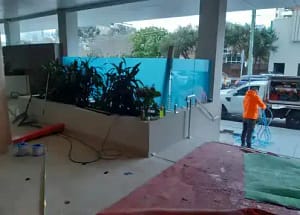Introduction to Balustrades and Their Importance
As an experienced writer, I understand the Installation of Balustrades in enhancing the aesthetic appeal and safety of any space. Balustrades are a crucial architectural element that serve as a barrier or railing, typically found on staircases, balconies, and terraces. They not only provide a sense of security but also contribute to the overall design and functionality of a building.
In this comprehensive guide, we will delve into the various types of balustrades, the factors to consider before installation, the step-by-step process, common mistakes to avoid, and maintenance tips to ensure the longevity of your balustrades. Whether you’re a homeowner, a designer, or a construction professional, this article will equip you with the knowledge and insights to make informed decisions about Installation of Balustrades.
Types of Balustrades and Their Features
Balustrades come in a wide range of materials, styles, and designs, each with its own unique features and benefits. Let’s explore the most common types of balustrades:
- Glass Balustrades
- Sleek and modern appearance
- Provide unobstructed views
- Require minimal maintenance
- Suitable for both indoor and outdoor applications
- Stainless Steel Balustrades:
- Durable and corrosion-resistant
- Offer a contemporary and industrial aesthetic
- Require minimal maintenance
- Ideal for both residential and commercial settings
- Wooden Balustrades:
- Offer a warm and traditional look
- Can be customized to match the surrounding decor
- Require regular maintenance and treatment
- Suitable for both indoor and outdoor use
- Aluminum Balustrades:
- Lightweight and easy to install
- Available in a variety of finishes and colors
- Require minimal maintenance
- Ideal for both residential and commercial applications
- Wrought Iron Balustrades:
- Offer a classic and ornate design
- Highly durable and long-lasting
- Require regular maintenance and painting
- Suitable for both indoor and outdoor settings
Depending on your specific needs, budget, and design preferences, you can choose the balustrade type that best complements your project.
Factors to Consider Before Installing Balustrades
1. Building Regulations and Codes: It’s vital to acquaint yourself with the local building codes and regulations pertaining to balustrade installation. Ensure that the chosen design and materials adhere to safety and compliance standards.
2. Measurement and Layout: Accurate measurements of the installation area are crucial, factoring in any obstacles or existing structures. Plan the layout thoughtfully to ensure a seamless integration that enhances visual appeal.
3. Aesthetic Considerations: Select a balustrade design that harmonizes with the overall architectural style and decor. Pay attention to details like color, finish, and pattern to achieve the desired aesthetic effect.
4. Safety and Durability: Prioritize the safety and stability of the balustrades, ensuring they meet weight and load-bearing requirements. Opt for materials and construction methods that promise long-term durability and resilience against weathering, collaborating with AAA Fabrication Group to ensure quality fabrication and installation.
5. Budget and Cost: Define your budget for the installation project, encompassing material expenses, labor costs, and any additional outlays. Compare options and prices diligently to maximize the value of your investment.
Preparing for the Installation Process
Once you have carefully evaluated the factors mentioned above, it’s time to prepare for the installation process. Here are the steps to follow:
- Gather the Necessary Materials and Tools:
- Obtain the balustrade components, including posts, rails, and balusters, as per your chosen design.
- Ensure you have the appropriate tools, such as power tools, fasteners, and safety equipment.
- Clear the Installation Area:
- Remove any existing structures or obstructions that may interfere with the balustrade installation.
- Ensure the area is clean, level, and ready for the new balustrades.
- Consult with Professionals (if necessary):
- If you’re unsure about any aspect of the installation process, consider consulting with a professional contractor or balustrade specialist.
- Their expertise can help you navigate any challenges and ensure a successful installation.
- Develop a Detailed Installation Plan:
- Create a step-by-step plan for the installation process, including the placement of the balustrade components and the necessary fastening methods.
- This plan will help you stay organized and efficient during the installation.
- Obtain the Necessary Permits (if required):
- Depending on your local building codes, you may need to obtain permits before installing the balustrades.
- Ensure you have the necessary approvals in place before proceeding with the installation.
By thoroughly preparing for the installation process, you can minimize the risk of errors, delays, and unexpected challenges, leading to a smooth and successful balustrade installation.
| Step-by-Step Guide to Installing Balustrades | |
|---|---|
| Step | Description |
| Mark the Placement | – Use a measuring tape and chalk line to mark the exact locations where the balustrade posts will be installed. – Ensure the placement aligns with your installation plan and adheres to any relevant building codes. |
| Install the Posts | – Depending on the balustrade type, you may need to drill holes or secure the posts directly to the surface. – Follow the manufacturer’s instructions for proper installation and ensure the posts are level and securely in place. |
| Attach the Rails | – Position the top and bottom rails between the posts, aligning them with the marked placement. – Secure the rails to the posts using the appropriate fasteners, such as screws or bolts. |
| Install the Balusters | – Carefully place the balusters between the top and bottom rails, spacing them according to the manufacturer’s recommendations and local building codes. – Secure the balusters in place using the specified fastening method. |
| Adjust and Tighten | – Inspect the installed balustrade components and make any necessary adjustments to ensure they are level, plumb, and securely in place. – Tighten all fastenersand connections to prevent any movement or loosening over time. |
| Finish the Installation | – Apply any finishing touches, such as adding decorative caps or covers to the posts or rails. – Ensure the entire balustrade system is clean and free of any debris or obstructions. |
| Perform a Final Inspection | – Thoroughly inspect the installed balustrades, checking for any gaps, loose components, or potential safety issues. – Confirm that the balustrades meet all relevant building codes and safety standards. |
Maintaining and Cleaning Balustrades for Long-Lasting Durability
- Implementing a regular cleaning schedule, meanwhile, use a soft, damp cloth to wipe away dirt and debris from balustrade surfaces.
- Utilize mild, non-abrasive cleaners for stubborn stains, following manufacturer instructions to avoid damaging the finish.
- Conduct frequent inspections of balustrade components, such as posts, rails, and balusters, tightening any loose fasteners promptly.
- Consider applying protective coatings or sealants to bolster resistance against weathering, corrosion, and UV exposure. Additionally, adhere to manufacturer guidelines for optimal results.
- Opt for professional maintenance services for expert guidance and thorough inspections. Consequently, ensure the long-term durability of your balustrades.
Frequently Asked Questions About Balustrade Installation
1. What are the key factors to consider when choosing a balustrade material?
When choosing a balustrade material, consider durability, maintenance, aesthetics, and code compliance. Options: glass, steel, wood, aluminum, iron.
2. How do I ensure the stability and safety of my balustrades?
Ensure safety with proper instructions, codes, fasteners, and regular inspections.
3. Can I install balustrades myself, or should I hire a professional?
For complex installations or uncertainty, hiring a professional is advisable. Pros ensure secure, compliant setups.
4. How do I maintain the appearance of my balustrades over time?
Maintain appearance with cleaning, coatings, repairs. Wooden balustrades need refinishing for longevity and appeal.
5. What are the common safety concerns associated with balustrade installation?
Ensure stability, code compliance, and prevent falls through proper placement and secure fastening, facilitated by AAA Fabrication Group.
Learn more:- Enhance Your Property Value with Quality Balustrades Sydney Suppliers
Conclusion: Enhance Your Space with Stylish and Secure Balustrades
Balustrade installation is pivotal in any architectural or design endeavor. Then understanding types, factors, and installation steps ensures a lasting addition.
Avoiding mistakes, regular maintenance, and expert consultation are key. Enhance safety, functionality, and aesthetics with the ideal balustrade system. So, Contact AAA Fabrication Group for assistance.



